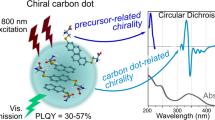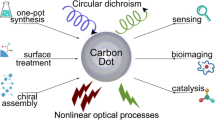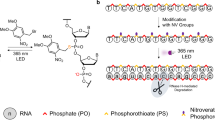Abstract
Gene editing is an important genetic engineering technique that enables gene manipulation at the molecular level. It mainly relies on engineered nucleases of biological origin, whose precise functions cannot be replicated in any currently known abiotic artificial material. Here, we show that chiral cysteine-modified CdTe nanoparticles can specifically recognize and, following photonic excitation, cut at the restriction site GAT′ATC (′ indicates the cut site) in double-stranded DNA exceeding 90 base pairs, mimicking a restriction endonuclease. Although photoinduced reactive oxygen species are found to be responsible for the cleavage activity, the sequence selectivity arises from the affinity between cysteine and the conformation of the specific DNA sequence, as confirmed by quantum-chemical calculations. In addition, we demonstrate non-enzymatic sequence-specific DNA incision in living cells and in vivo using these CdTe nanoparticles, which may help in the design of abiotic materials for gene editing and other biological applications.
This is a preview of subscription content, access via your institution
Access options
Access Nature and 54 other Nature Portfolio journals
Get Nature+, our best-value online-access subscription
$29.99 / 30 days
cancel any time
Subscribe to this journal
Receive 12 print issues and online access
$259.00 per year
only $21.58 per issue
Buy this article
- Purchase on SpringerLink
- Instant access to full article PDF
Prices may be subject to local taxes which are calculated during checkout






Similar content being viewed by others
References
Jones, M. R., Seeman, N. C. & Mirkin, C. A. Nanomaterials. Programmable materials and the nature of the DNA bond. Science 347, 1260901 (2015).
Yang, M. et al. Self-assembly of nanoparticles into biomimetic capsid-like nanoshells. Nat. Chem. 9, 287–294 (2017).
Mao, L. B. et al. Synthetic nacre by predesigned matrix-directed mineralization. Science 354, 107–110 (2016).
Pelaz, B. et al. The state of nanoparticle-based nanoscience and biotechnology: progress, promises, and challenges. ACS Nano 6, 8468–8483 (2012).
Fan, K. et al. Magnetoferritin nanoparticles for targeting and visualizing tumour tissues. Nat. Nanotech. 7, 459–464 (2012).
Wang, X. Y., Hu, Y. H. & Wei, H. Nanozymes in bionanotechnology: from sensing to therapeutics and beyond. Inorg. Chem. Front. 3, 41–60 (2016).
Aiba, Y., Sumaoka, J. & Komiyama, M. Artificial DNA cutters for DNA manipulation and genome engineering. Chem. Soc. Rev. 40, 5657–5668 (2011).
Xiao, X. J., Wu, T. B., Gu, F. D. & Zhao, M. P. Generation of artificial sequence-specific nucleases via a preassembled inert-template. Chem. Sci. 7, 2051–2057 (2016).
Liu, B., Sun, Z., Huang, P. J. & Liu, J. Hydrogen peroxide displacing DNA from nanoceria: mechanism and detection of glucose in serum. J. Am. Chem. Soc. 137, 1290–1295 (2015).
Liu, Y. et al. Biomimetic enzyme nanocomplexes and their use as antidotes and preventive measures for alcohol intoxication. Nat. Nanotech. 8, 187–192 (2013).
Tonga, G. Y. et al. Supramolecular regulation of bioorthogonal catalysis in cells using nanoparticle-embedded transition metal catalysts. Nat. Chem. 7, 597–603 (2015).
Rouge, J. L. et al. Ribozyme–spherical nucleic acids. J. Am. Chem. Soc. 137, 10528–10531 (2015).
Sun, H. J. et al. Deciphering a nanocarbon-based artificial peroxidase: chemical identification of the catalytically active and substrate-binding sites on graphene quantum dots. Angew. Chem. Int. Ed. 54, 7176–7180 (2015).
Huang, Y. et al. Self-assembly of multi-nanozymes to mimic an intracellular antioxidant defense system. Angew. Chem. Int. Ed. 55, 6646–6650 (2016).
Zetsche, B. et al. Cpf1 is a single RNA-guided endonuclease of a Class 2 CRISPR-Cas system. Cell 163, 759–771 (2015).
Loenen, W. A., Dryden, D. T., Raleigh, E. A., Wilson, G. G. & Murray, N. E. Highlights of the DNA cutters: a short history of the restriction enzymes. Nucleic Acids Res. 42, 3–19 (2014).
Xu, Z., Zan, H., Pone, E. J., Mai, T. & Casali, P. Immunoglobulin class-switch DNA recombination: induction, targeting and beyond. Nat. Rev. Immunol. 12, 517–531 (2012).
Cong, L. et al. Multiplex genome engineering using CRISPR/Cas systems. Science 339, 819–823 (2013).
Roberts, R. J., Vincze, T., Posfai, J. & Macelis, D. REBASE—a database for DNA restriction and modification: enzymes, genes and genomes. Nucleic Acids Res. 43, D298–D299 (2014).
Kameshima, W. et al. Conjugation of peptide nucleic acid with a pyrrole/imidazole polyamide to specifically recognize and cleave DNA. Angew. Chem. Int. Ed. 52, 13681–13684 (2013).
Wang, X., Sun, G., Li, N. & Chen, P. Quantum dots derived from two-dimensional materials and their applications for catalysis and energy. Chem. Soc. Rev. 45, 2239–2262 (2016).
Bhatia, D. et al. Quantum dot-loaded monofunctionalized DNA icosahedra for single-particle tracking of endocytic pathways. Nat. Nanotech. 11, 1112–1119 (2016).
Zrazhevskiy, P. & Gao, X. Quantum dot imaging platform for single-cell molecular profiling. Nat. Commun. 4, 1619 (2013).
Yan, W. et al. Self-assembly of chiral nanoparticle pyramids with strong R/S optical activity. J. Am. Chem. Soc. 134, 15114–15121 (2012).
Wang, Y., Fedin, I., Zhang, H. & Talapin, D. V. Direct optical lithography of functional inorganic nanomaterials. Science 357, 385–388 (2017).
Li, S. et al. Dual-mode ultrasensitive quantification of microRNA in living cells by chiroplasmonic nanopyramids self-assembled from gold and upconversion nanoparticles. J. Am. Chem. Soc. 138, 306–312 (2016).
Yeom, J. et al. Chiral templating of self-assembling nanostructures by circularly polarized light. Nat. Mater. 14, 66–72 (2014).
Zhao, X. et al. Gold–quantum dot core–satellite assemblies for lighting up microRNA in vitro and in vivo. Small 12, 4662–4668 (2016).
Li, X. B. et al. Self-assembled framework enhances electronic communication of ultrasmall-sized nanoparticles for exceptional solar hydrogen evolution. J. Am. Chem. Soc. 139, 4789–4796 (2017).
Feng, W. et al. Assembly of mesoscale helices with near-unity enantiomeric excess and light-–matter interactions for chiral semiconductors. Sci. Adv. 3, e1601159 (2017).
Hendry, E. et al. Ultrasensitive detection and characterization of biomolecules using superchiral fields. Nat. Nanotech. 5, 783–787 (2010).
Kotov, N. A. Inorganic nanoparticles as protein mimics. Science 330, 188–189 (2010).
Ma, W. et al. Chiral inorganic nanostructures. Chem. Rev. 117, 8041–8093 (2017).
Zhou, Y. L., Yang, M., Sun, K., Tang, Z. Y. & Kotov, N. A. Similar topological origin of chiral centers in organic and nanoscale inorganic structures: effect of stabilizer chirality on optical isomerism and growth of CdTe nanocrystals. J. Am. Chem. Soc. 132, 6006–6013 (2010).
Boersma, A. J. et al. Catalytic enantioselective syn hydration of enones in water using a DNA-based catalyst. Nat. Chem. 2, 991–995 (2010).
Mukhina, M. V. et al. Intrinsic chirality of CdSe/ZnS quantum dots and quantum rods. Nano Lett. 15, 2844–2851 (2015).
Gao, F. L. et al. A singlet oxygen generating agent by chirality-dependent plasmonic shell–satellite nanoassembly. Adv. Mater. 29, 1606864 (2017).
Lesnyak, V., Gaponik, N. & Eychmuller, A. Colloidal semiconductor nanocrystals: the aqueous approach. Chem. Soc. Rev. 42, 2905–2929 (2013).
Burns, J. R., Seifert, A., Fertig, N. & Howorka, S. A biomimetic DNA-based channel for the ligand-controlled transport of charged molecular cargo across a biological membrane. Nat. Nanotech. 11, 152–156 (2016).
Kim, Y., Geiger, J. H., Hahn, S. & Sigler, P. B. Crystal structure of a yeast TBP/TATA-box complex. Nature 365, 512–520 (1993).
Yan, Z. & Wang, J. SPA-LN: a scoring function of ligand–nucleic acid interactions via optimizing both specificity and affinity. Nucleic Acids Res. 45, e110 (2017).
Tang, Z. Y., Zhang, Z. L., Wang, Y., Glotzer, S. C. & Kotov, N. A. Self-assembly of CdTe nanocrystals into free-floating sheets. Science 314, 274–278 (2006).
Boles, M. A. & Talapin, D. V. Self-assembly of tetrahedral CdSe nanocrystals: effective ‘patchiness’ via anisotropic steric interaction. J. Am. Chem. Soc. 136, 5868–5871 (2014).
Yang, Y. A., Wu, H. M., Williams, K. R. & Cao, Y. C. Synthesis of CdSe and CdTe nanocrystals without precursor injection. Angew. Chem. Int. Ed. 44, 6712–6715 (2005).
Chen, Y. Z. et al. Singlet oxygen-engaged selective photo-oxidation over Pt nanocrystals/porphyrinic MOF: the roles of photothermal effect and Pt electronic state. J. Am. Chem. Soc. 139, 2035–2044 (2017).
Li, H. et al. New reaction pathway induced by plasmon for selective benzyl alcohol oxidation on BiOCl possessing oxygen vacancies. J. Am. Chem. Soc. 139, 3513–3521 (2017).
Xue, T. et al. Integration of molecular and enzymatic catalysts on graphene for biomimetic generation of antithrombotic species. Nat. Commun. 5, 3200 (2014).
Chandrasekar, J. & Silverman, S. K. Catalytic DNA with phosphatase activity. Proc. Natl Acad. Sci. USA 110, 5315–5320 (2013).
Sun, M. et al. Intracellular localization of nanoparticle dimers by chirality reversal. Nat. Commun. 8, 1847 (2017).
Zheng, J. et al. Rationally designed molecular beacons for bioanalytical and biomedical applications. Chem. Soc. Rev. 44, 3036 (2015).
Acknowledgements
This work was supported financially by the National Natural Science Foundation of China (21522102, 21631005, 21771090, 21673104 and 21471068). We also thank the Brazilian funding agencies Financiadora de Estudos e Projetos (FINEP) and Fundação de Amparo à Pesquisa do Estado de São Paulo (FAPESP; grants 2012/15147-4 and 2013/07296-2) for financial support. The authors acknowledge the National Laboratory for Scientific Computing (LNCC/MCTI, Brazil) and UFSCar for providing the high-performance computing resources of the SDumont supercomputer (http://sdumont.lncc.br) and of the Could@UFSCar, respectively, both of which have contributed to the results reported in this paper. A.F.d.M. thanks Ministério da Educação/Programa de Educação Tutorial for a fellowship.
Author information
Authors and Affiliations
Contributions
H.K., N.A.K. and C.X. conceived the project and designed the experiments. M.S. was responsible for DNA cutting and spectroscopic measurements. L.X. and A.Q. carried out cell and ITC experiments. T.H. and A.Q. were responsible for chiral CdTe nanoparticles synthesis and DNA electrophoresis. W.M. and C.H. carried out synchrotron small-angle X-ray scattering, X-ray photoelectron spectroscopy and transient absorption spectrum experiments. F.M.C and A.F.M. developed the models for free energy calculation. P.Z. and X.W. developed the DFT model. H.K. and M.S. carried out the studies in vivo. H.K. conceptualized the work. C.X. supervised the study and N.A.K. provided advice regarding the idea. H.K. and C.X. analysed the results and wrote the manuscript. H.K., C.X. and N.A.K. discussed the results and commented on the manuscript.
Corresponding author
Ethics declarations
Competing interests
The authors declare no competing interests.
Additional information
Publisher’s note: Springer Nature remains neutral with regard to jurisdictional claims in published maps and institutional affiliations.
Supplementary information
Supplementary Information
Supplementary characterization and calculation details, Supplementary Figures 1–156, Supplementary Tables 1–17
Rights and permissions
About this article
Cite this article
Sun, M., Xu, L., Qu, A. et al. Site-selective photoinduced cleavage and profiling of DNA by chiral semiconductor nanoparticles. Nature Chem 10, 821–830 (2018). https://doi.org/10.1038/s41557-018-0083-y
Received:
Accepted:
Published:
Issue Date:
DOI: https://doi.org/10.1038/s41557-018-0083-y



